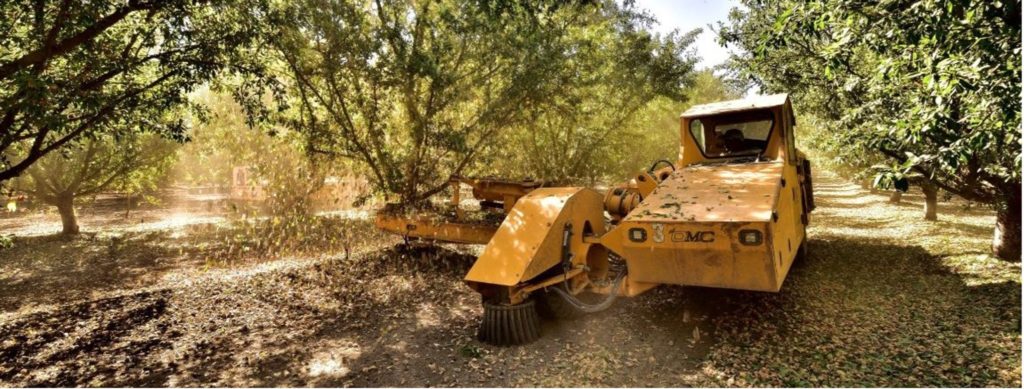
November/December 2023
Almond harvest difficulties in 2023
In 2023, a late spring bloom accompanied by untimely rains and lower than normal temperatures delayed California’s almond harvest for the year.
Compared to recent seasons, growers experienced higher rates of disease with more incidences of pests being reported.
The first shakings, which typically begin in small volumes in late July and in more regular volume in early August, didn’t commence until the middle of August, two to three weeks later than usual for most varieties.
Cool keeps blooms on trees, slows crop
“It’s an unusual year all around in some respects,” said Richard Waycott, president and chief executive officer of the Almond Board of California. “The bloom period was very protracted, and it was cool, windy and rainy. Temperatures in the Central Valley between bloom and the start of harvest were uncharacteristically on the cool side, and we had a couple of unusual rain events. All those factors combined to push the beginning of the harvest back 10 days to three weeks, depending on where you are and the varieties.”
Because the three-week February bloom wasn’t early and fast, the usual overlap between the blooming varieties didn’t ensure almond trees received adequate pollination necessary for impregnating the flowers, Waycott said.
Most growers started considerably later than normal in the southern part of the Central Valley, said Blake Sanden, University of California Cooperative Extension (UCCE) irrigation and agronomy farm advisor emeritus for Kern County.
“This has been a really strange startup to the season because we had all the rain, the cooler weather earlier this year and that bloom was all over the map,” he said. “The early season heat units were behind where they normally are. The initiation and precision of hull split was definitely behind this year compared to what we normally like to see.”
The inclement weather disrupted bee flight hours and pollination.
“Springtime was so cold and wet, we didn’t have as much bee activity for pollination,” said Brent Holtz, UCCE county director and farm advisor for San Joaquin County.
High insect and disease pressures
Naval orange worm (NOW) damage is reported to be high, some incidences higher than 15%, said Mae Culumber, UCCE nut crops advisor for Fresno and Kings counties. “NOW damage has been associated with increased incidence of fungal contamination including Aspergillus molds and aflatoxin contamination,” she said.
Late summer rains in some areas further delayed harvests, increasing susceptibility to NOW infestations and crop damage. The rain and mild temperatures during harvest for early varieties also slowed in-field drying, with many orchards seeing increased mold and staining damage, Culumber said.
For the most part, trees looked green and were happily growing throughout the season, she said. The wet spring followed by a cooler June allowed trees to utilize soil moisture and nutrients for a longer duration before the summer heat set in. In some areas where drainage was slow and saturated soil persisted, there were increased incidences of phytophthora and other soil borne diseases.
The north-central part of the valley was experiencing more NOW damage, Holtz noted.
“We have heard reports that this could be one of the worst NOW years we have had in a decade, maybe a couple of decades,” he said.
One of the ways growers can manage NOWs is by harvesting early, ande attempt to get the crop off before the pest’s fourth flight, Holtz said. Proper winter sanitation, including shaking and poling to remove remaining mummy nuts, can help reduce NOW incidences, he said.
Cool and sometimes freezing temperatures along with moist conditions during late bloom and around nut set were the perfect conditions for a variety of foliar diseases, including bacterial blast, jacket rot and brown rot, Culumber said.
“Growers were unable to access the orchard with ground sprayers to make bactericide and fungicide applications during bloom,” she said. “Many growers primarily relied on aerial applications, and it was not always possible to make an application with the optimal timing to avoid disease infections.”
Growers trying to reduce expenses by not sanitizing as frequently could have caused more infestations, said Phoebe Gordon, UCCE orchard crops farm advisor for Madera and Merced counties.
“There’s a lot of mummies in trees because you need to destroy mummies to remove that first food source for the first flight to lay their eggs on as well as killing overwintering larvae, and that just led to high population levels,” she said. “We have high populations and a lot of damage this year.”
Northern Sacramento Valley growers are experiencing high NOW infestations, said Luke Milliron, UCCE orchard systems advisor for Butte, Glenn and Tehama counties. Growers that may have experienced 0.5% to 3% damage in past seasons this year may witness considerably higher damage percentages, he said.
“I am hearing some horror stories on the west side of 20%,” Milliron said. “It’s a really terrible situation.”
Northern San Joaquin Valley growers weren’t as affected by the rains as others, Gordon said.
“Once the rains started, they kind of didn’t stop,” she said. “There were a couple of windows here and there. Some growers had trouble getting into orchards.”
If nuts were on the ground and growers were planning to pick them up the next day, the rains may have caused some problems, but, as long as the weather holds in her area, Gordon said she thinks things should work out.
In the northern Sacramento Valley, the atmospheric rivers and saturation helped growers who didn’t experience any significant flooding problems, Milliron said. Unlike other areas of the state that experienced significant flooding, Northern California growers who planted cover crops or worked with strong vegetation did a good job of capturing the excessive rains and the atmospheric rivers didn’t lead to a lot of puddling, he said. Favorable leaching of salts helped growers.







